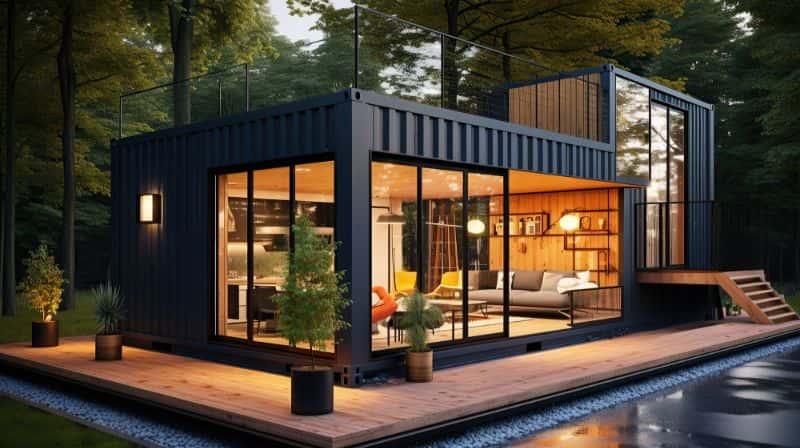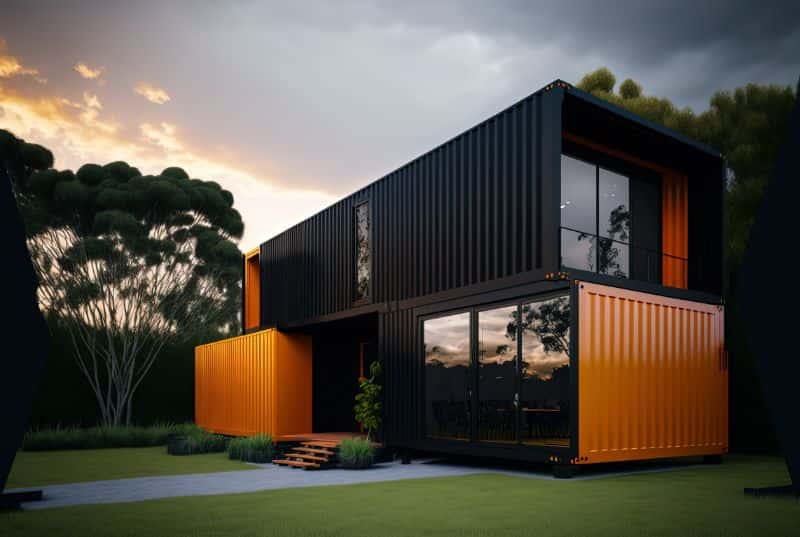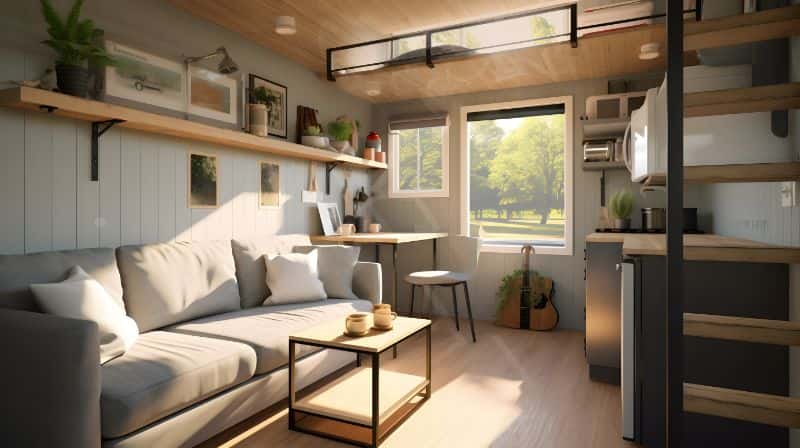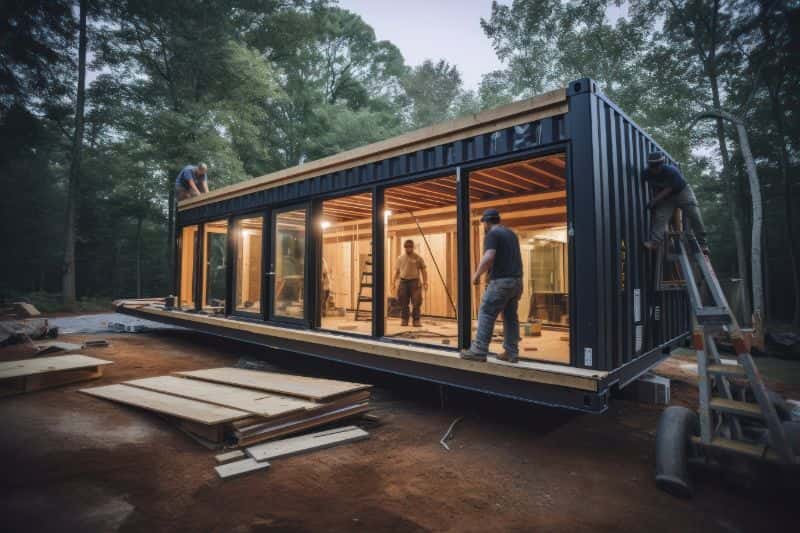Ontario’s Building Code allows shipping containers of 160 to 320 square feet to be used as structures on a piece of land. The placement of these containers exceeding an area of 10 square meters will require a building permit.
Container homes can be constructed in Ontario’s rural areas according to local zoning by-laws and building codes. You need to check with the proper authorities before doing your construction to ensure they are aligned to your local area’s regulations.

Container homes are sustainable, affordable, and environment-friendly living spaces. Over the years, they have become a practical housing solution in Ontario. These steel boxes were originally used for transporting goods across the world. Homeowners can repurpose these containers for residential purposes.
Are you interested in building a container home? Find out the legalities in Ontario and get more ideas for your project.
Fill out the short online form on this page to connect with expert contractors in your area, free of charge.
Why do homeowners like container homes?

Shipping containers have become popular as container homes in Ontario due to a number of reasons:
Sustainability: These containers, when repurposed, reduce waste and lower the demand for construction materials. This supports the province of Ontario’s goal to preserve our natural environment.
Affordability: Container homes cost a lot less than traditional or standard homes. Containers are cheaper to buy and are structurally suitable as a housing alternative for Ontario residents who want to economize.
Flexibility: Containers can be stacked and designed in various configurations to fit the space available. Homeowners can customize their livable space based on their needs.
Ease of Construction: Container homes take less time to build than traditional homes.
Are you looking for a sustainable and affordable housing solution? A container home could be the answer you are searching for.
Request a quote from our partner contractors using our short online form today at no cost.
What are the types of shipping containers for container homes?

Shipping containers come in 20-ft and 40-ft sizes. Both dimensions can provide adequate space for residential use. The average height of shipping containers is 8 feet x 6 inches but you can also find containers that are 9 feet x 6 inches. The latter are called high-cube containers.
High-cube containers are advantageous for living spaces as they provide more space vertically for interior finishes and insulation.
You need to consider the land area for your container home when selecting the right size for your container home.
Container types to consider:
The standard cargo container is the most popular choice for container homes. However, there are specialized containers that can be utilized for specific projects. These include:
Open-top containers: Without a solid roof and can be used for tall interior spaces.
Insulated containers: Originally designed to control temperature, these containers are useful for areas with extreme weather conditions.
Refrigerated containers: Equipped with refrigeration units, these are suitable for use as food-related structures.
These specialized containers are more expensive than standard containers. Most builders would still recommend using the regular dry cargo container for affordability.
Understanding Container Conditions in building a container home

The condition of the shipping containers to be used in in building a container home is very important. If you use containers that are not structurally sound, the longevity and safety of the container home will be compromised.
You must assess the structural integrity of the containers before buying them for your container home.
Shipping containers have various grades as follows:
One-Trip Containers: These are containers that were used only once to transport cargo and thus, are relatively new. They are in excellent condition and have little or no signs of wear and tear. These are the most ideal for use in container homes.
Cargo-Worthy: Containers that are considered cargo-worthy have been inspected and found suitable for cargo transport. While still in good condition in terms of transportation, they show signs of wear and tear. For homeowners looking to save money, cargo-worthy containers can still be a reliable option for container home construction.
Wind and Water Tight Containers: Also called WWT containers, these are old containers that no longer meet the standards for cargo transport. They show signs of age but could still be structurally sound and able to resist water and wind. They will need additional repairs to make sure they are suitable for residential use.
As-Is Containers: These containers are sold in whatever condition they are in with no certification or warranties. They show dents, rust, or structural problems. They are sold at lower prices but will require additional repairs. Thus, they are the least suitable for building a container home.
Estimate how many square feet you want for your home to calculate how many containers you need.
Find containers that are in good condition for your project. You can use our short online form at no cost to connect with top contractors near you.
How much is a container home in Ontario?

Constructing a container home varies based on factors such as the container size, custom design, site preparation, and interior finishes. Although container homes are significantly cheaper than traditional homes, you also need to consider all expenses when preparing your budget.
Below is a list of average expenses related to building a container home.
Shipping containers: The cost of the container also varies based on size and condition. Newer ones are more expensive and could cost around $2,000 to $4,000 for a 20-ft container and around $3,500 to $8,000 for a 40-ft container. There is also a charge for the delivery of the containers to your location.
Site preparation: Land clearing, installation of the foundation, permit costs, and utility connections also incur costs.
Construction: The cost to construct your container home depends on the design and interior finishes. Consult with an architect or a contractor to get a clearer idea of the actual cost based on your design plan.
Utilities: Electrical wiring, plumbing, and HVAC systems are necessary for your container home. The cost of these connections will depend on the size of your home and your selected materials.
Finishes and Furnishings: To make your container home convenient, comfortable, and aesthetically pleasing, you will need to install flooring, cabinets, appliances, furniture, etc. You need to set aside a budget for these elements.
How much to budget to build a container home
While a container could cost around $5,000 or more, to build a container home that is suitable for living in could run up to $25,000 or more. The actual cost depends on the size of the home, design, finishing touches, and land value.
Standard container homes cost from $25,000 to $50,000 but larger ones with multiple shipping containers and customized elements could cost from $120,000 to $200,000.
The total cost will include labour costs, installation of utilities and systems, furnishings, doors and windows, etc.
Factors to consider when designing a Container Home

When choosing the design of your container home, consider how to maximize space, function, and aesthetic appeal.
The following architectural considerations are worthy of your attention.
Natural Light: Allowing natural light into the home will brighten your space and create an inviting home. Include large windows, skylights, and glass doors to bring in natural light and reduce your energy use.
Energy Efficiency: Lower utility costs with energy-efficient elements like LED lighting, efficient appliances, and good insulation.
Compact Space: Container homes need to be compact in design to utilize every square foot efficiently. Use built-in elements for storage and multi-functional furniture.
An architect or designer can help you come up with the best design for your container home tailored to your needs and budget.
Connect with professionals you need to build your container home using our short online form! Compare Home Quotes has a vast network or design and building professionals for all types of projects.
Pros and Cons of Container Homes
You may have heard some people raving about living in tiny homes or container homes as a cheaper alternative to larger and traditional homes.
Yes, they have become popular in Ontario and for good reasons. Below are the most important benefits of container homes.
Durability
Shipping containers are tough and can resist extreme weather conditions. Their steel frame and walls are strong.
As containers are designed to protect cargo, you can benefit from the same strong structure for your home.
Speedy construction
A container home is faster to build than traditional wood or concrete homes. As they are smaller, the construction is simpler and may require only some modifications to complete.
Portability
One unique benefit of container homes is portability. Unlike traditional homes, they can be moved to another location if the need arises.
Cheaper Cost
It is cheaper to build a container home than a traditional home. Since container homes are smaller, they need fewer materials. The labour cost is also much lower.
Unique Designs
Shipping containers offer great design flexibility compared to traditional construction materials.
The Disadvantages of building a container home
Shipping containers are not exactly in abundant supply in Canada. It can be challenging to find suitable containers in good condition for building a container home.
You should also remember that container homes offer minimalist living. The livable space of a container home is much smaller than a standard home.
In the summer months, it can get quite warm living in a container home without a proper cooling system and insulation. To compensate, you must have a built-in air conditioner and proper wall finish and vents. This will improve the aesthetics of your home but it will also reduce your already small space.
Can you get a mortgage for a container home?
ou could probably get an uninsured mortgage for a fully-built container home. You will need to pay at least 20% for the down payment as CMHC will probably not insure this type of dwelling.
Steps to Get Started in Building your Container Home in Ontario

Before you start building your container home, you will need to comply with the building codes and regulations of the province.
Permits and Design
Obtaining the necessary permits and consulting with local authorities is important from the get-go. These will help ensure you follow the prescribed setbacks from property lines, maximum allowed building height, and materials and designs allowed.
We recommend working with a professional builder, architect, or contractor to assist you with the paperwork, design, and construction.
Once the paperwork is completed, site preparation comes next. Land clearing and leveling the land will be undertaken by the contractor to prepare a good foundation for your home.
Installing the Foundation
There are a few options for the foundation – concrete slab, piers, or beams. A good foundation is necessary to ensure your container home will last a long time.
Reinforcements and Modifications
Modifications can be done to create a stable structure for your home. They must meet the requirements of Ontario’s building codes. These modifications include installing windows, doors, reinforcing walls, or removing some sections of the shipping container to customize the space.
Roofing and Insulation
After the foundation and structural modifications are completed, roofing and insulation comes next. Both are important to ensure safety and comfort.
Utilities
At the end of the construction, plumbing, electrical work, and HVAC systems will be installed. For safety, hire licensed electricians and plumbers to do the work.
Constructing a container home in Ontario is not something to be done lightly. It will involve careful planning, compliance with provincial regulations, and skilled labour.
Whether you want to build a small or a family-sized container home, work with the right professionals for a successful project.







